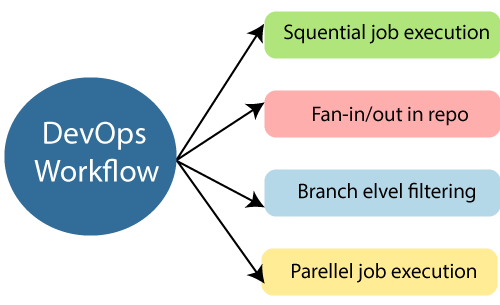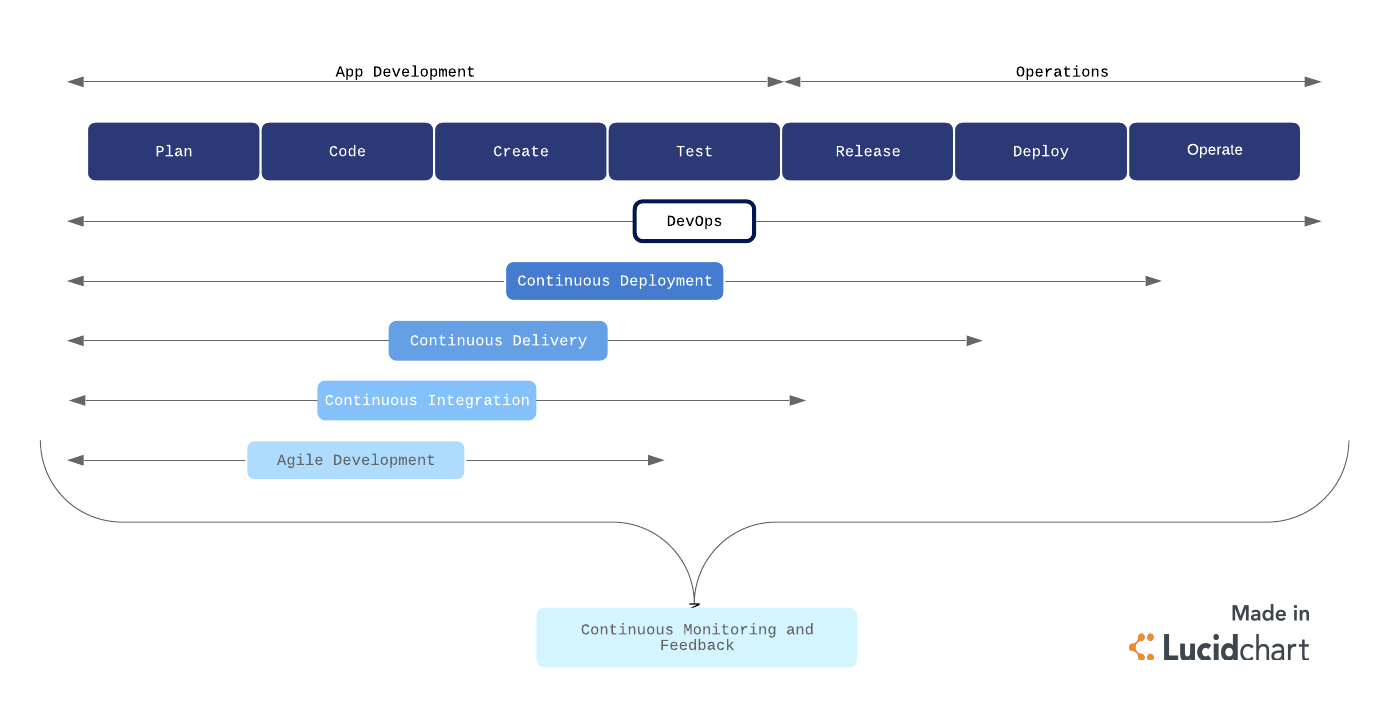If you are interested to learn about the DevOps Lifecycle
DevOps workflow provides a visual overview of the sequence in which input is provided. Also, it tells about which one action is performed, and output is generated for an operations process.

DevOps workflow allows the ability to separate and arrange the jobs which are top requested by the users. Also, it gives the ability to mirror their ideal process in the configuration jobs.
DevOps Principles
The main principles of DevOps are Continuous delivery, automation, and fast reaction to the feedback.
- End to End Responsibility: DevOps team need to provide performance support until they become the end of life. It enhances the responsibility and the quality of the products engineered.
- Continuous Improvement: DevOps culture focuses on continuous improvement to minimize waste. It continuously speeds up the growth of products or services offered.
- Automate Everything: Automation is an essential principle of the DevOps process. This is for software development and also for the entire infrastructure landscape.
- Custom Centric Action: DevOps team must take customer-centric for that they should continuously invest in products and services.
- Monitor and test everything: The DevOps team needs to have robust monitoring and testing procedures.
- Work as one team: In the DevOps culture role of the designers, developers, and testers are already defined. All they needed to do is work as one team with complete collaboration.
These principles are achieved through several DevOps practices, which include frequent deployments, QA automation, continuous delivery, validating ideas as early as possible, and in-team collaboration.
DevOps Practices
Some identified DevOps practices are:
- Self-service configuration
- Continuous build
- Continuous integration
- Continuous delivery
- Incremental testing
- Automated provisioning
- Automated release management
The DevOps process flow is all about agility and automation. Each phase in the DevOps lifecycle focuses on closing the loop between development and operations and driving production through continuous development, integration, testing, monitoring and feedback, delivery, and deployment.

Continuous development
Continuous development is an umbrella term that describes the iterative process for developing software to be delivered to customers. It involves continuous integration, continuous testing, continuous delivery, and continuous deployment. By implementing a continuous development strategy and its associated sub-strategies, businesses can achieve faster delivery of new features or products that are of higher quality and lower risk, without running into significantly bandwidth barriers.
Continuous integration
Continuous integration (CI) is a software development practice commonly applied in the DevOps process flow. Developers regularly merge their code changes into a shared repository where those updates are automatically tested. Continuous integration ensures the most up-to-date and validated code is always readily available to developers. CI helps prevent costly delays in development by allowing multiple developers to work on the same source code with confidence, rather than waiting to integrate separate sections of code all at once on release day.
This practice is a crucial component of the DevOps process flow, which aims to combine speed and agility with reliability and security.
Continuous testing
Continuous testing is a verification process that allows developers to ensure the code actually works the way it was intended to in a live environment. Testing can surface bugs and particular aspects of the product that may need fixing or improvement, and can be pushed back to the development stages for continued improvement.
Continuous monitoring and feedback
Throughout the development pipeline, your team should have measures in place for continuous monitoring and feedback of the products and systems. Again, the majority of the monitoring process should be automated to provide continuous feedback.
This process allows IT operations to identify issues and notify developers in real time. Continuous feedback ensures higher security and system reliability as well as more agile responses when issues do arise. Use <strong>value stream mapping</strong> in DevOps.
Continuous delivery
Continuous delivery (CD) is the next logical step from CI. Code changes are automatically built, tested, and packaged for release into production. The goal is to release updates to the users rapidly and sustainably.
To do this, CD automates the release process (building on the automated testing in CI) so that new builds can be released at the click of a button.
Continuous deployment
For the seasoned DevOps organization, continuous deployment may be the better option over CD. Continuous deployment is the fully automated version of CD with no human (i.e., manual) intervention necessary.
In a continuous deployment process, every validated change is automatically released to users. This process eliminates the need for scheduled release days and accelerates the feedback loop. Smaller, more frequent releases allow developers to get user feedback quickly and address issues with more agility and accuracy. Continuous deployment is a great goal for a DevOps team, but it is best applied after the DevOps process has been ironed out. For continuous deployment to work well, organizations need to have a rigorous and reliable automated testing environment. If you’re not there yet, starting with CI and CD will help you get there.
Implementing DevOps in your organization
If you haven’t yet implemented a DevOps process in your organization, the task can seem daunting. Keep in mind—it is not only a process shift but a cultural shift as well. As you strive for successful DevOps adoption, consider implementing it in stages. Depending on where your organization currently stands, you may want to build on an agile approach for DevOps implementation. A gradual implementation sequence might look like this:
- Establish an agile development process
- Adopt cloud computing
- Adapt your processes to a CI and CD workflow
- Automate your software deployment
- Automate software testing
- Implement continuous deployment
Keep in mind that DevOps automation brings with it both an infrastructural and tooling shift. Without the proper infrastructure and tools to support your processes, you risk having gaps in your DevOps process flow. To create a true DevOps environment, each stage of the development pipeline should be as automated and agile as possible. Also consider how visuals can help you map out your DevOps processes and understand everything from who is working on what, to timelines, and process flows. Visuals can ease the implementation process, keeping everyone on the same page from the start.
DevOps tools to help you map your processes
While DevOps is as much about mindset as it is about process, there are still many moving parts to keep track of. As you adapt your processes to a DevOps environment, consider using these DevOps tools to stay on point.
- Git: A distributed source code management DevOps tool that allows you to track your development progress. Easily save or revert back to different versions of your source code and leverage features like branching, staging areas, and different workflow options.
- Lucid chart: A visual workspace that helps developers and IT managers create robust, easy-to-understand diagrams of processes, teams, and data. You can use Lucid chart as a DevOps tool to model your new DevOps process flow to train team members, document handoffs, track ongoing development progress, and keep everyone on the same page.
- Kubernetes: Take containerization to the next level by grouping into logical units, deploying in clusters, and automating distribution and scheduling. Kubernetes is a popular open-source system and DevOps tool that helps teams move their projects forward at scale.
- Raygun: Monitor your errors and crash reports with Raygun, an application performance monitoring platform. This DevOps tool can help you diagnose issues and track the error all the way back to a specific line of code, function, or API call.


